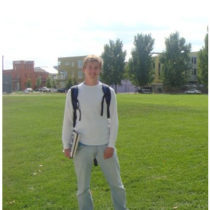Landscape Architecture for Landscape Architects › Forums › RESEARCH › Help on developing Thesis topic
- This topic has 1 reply, 6 voices, and was last updated 15 years, 2 months ago by
 Jason T. Radice.
Jason T. Radice.
-
AuthorPosts
-
September 27, 2010 at 1:55 am #167663
 Dayton CritesParticipant
Dayton CritesParticipantLong time listener, first time caller…
To any who would have thoughts, I could use some help in finding ways to develop the pursuit of a Thesis topic. I have just begun my MLA studies at Utah State University. I have been drawn to pursue this profession in a twofold manner:Specifically, that LA’s can play a role in developing urban (and rural) infrastructure to promote bicycle recreation and transportationGenerally, that it is a design profession that, at best, can contribute to elements of a better world (sustainable sites, stormwater solutions, environmental mitigation, etc)I have been trying to get towards an idea that would let my thesis contribute to the body of knowledge regarding bicycle infrastructure, particularly designs and approaches that get more people to USE the bicycle infrastructure.But that’s all I’ve got – I’m having a hard time going specific, figuring out what has been researched and established, and what has not been. Any suggestions on ways in which I should go about framing/finding my query from which to form a thesis?Books I should read?Thanks to all who take the time to reply.September 27, 2010 at 2:24 am #167673 Jason T. RadiceParticipant
Jason T. RadiceParticipantYou need to research the ‘Complete Streets” movement, of which there are many aspects. It is mostly implemented by departments of transportation as a way of incorperating bicycle and pedestrians in with vehicular traffic.
One very valuable resource for you will be the work of Jan Gehl. He’s a Danish architect and is a world-wide leader on bicycle and pedestrian advocacy in urban areas. His influence and work set up a model project in Copenhagen, DK, and has done a bunch of work in Austrialia, as well as consulted on the Times Square redesign in NYC. It just so happens he has just released a new book here in the States: Cities for People.
I had the pleasure of meeting Jan recently, and he has a great design philosophy, especially for an architect.
September 28, 2010 at 5:40 am #167672 Jonathan NelsenParticipant
Jonathan NelsenParticipantI am currently working on my thesis and one book that really helps is The Craft of Research by Booth, Colomb, and Williams. It really helps in developing your topic and focusing your research. check it out, you can pick it up on Amazon pretty cheap.
September 28, 2010 at 5:45 am #167671 Thomas J. JohnsonParticipant
Thomas J. JohnsonParticipantAs Jason eluded to below, Europe is leap years ahead of us in terms of bicycle oriented transportation design. There are a number of reasons for this but the main one is necessity, driven by the expense of gasoline ($8-$9/Gal. v.s. $3-$4 in the US) and cities that were built before the automobile that are more conducive to pedestrian and bicycle traffic and actually prohibit automobile use with narrow streets and a lack of parking.
When I was bicycle touring around the Netherlands, Germany, the Czech, Austria and Switzerland, the general consensus was that Europeans don’t ride bikes because it’s cool or “green”. They ride bikes because they don’t have a choice. They ride year around, rain, sleet or snow. They carry groceries, laundry (I even saw a guy hauling a huge log).
Unfortunately, I have little faith in the ability to convert Americans to a cycling culture, until we are forced to change, like the Europeans. Americans love their cars. Americans are lazy. Also, America is a big place and not everywhere is conducive to cycling. Super hilly areas stink for commuting, super cold is not realistic for most people and neither is super hot/humid. I’ve commuted year around in Chicago and it takes a lot of gumption to gear up when it’s below zero, likewise in the summer when it’s 90* with 100% humidity, you’re drenched in sweat after a block…
I’ve also lived in cycling utopia and have seen cycling work very well on a massive scale, year around (flat, not too hot, not too cold). There is some very good work being done in the United States in cities such as NY, Chicago, San Diego, Minneapolis, Seattle, Portland and Austin, to name a few.
Chicago used to have the Chicagoland Bicycle Federation – Now the more inclusive “Active Transportation Alliance”
http://www.activetrans.org/Alta Planning has done some major bicycle / pedestrian plans
http://www.altaplanning.com/Seattle used Alta to create the most comprehensive bicycle transportation plan in the U.S. Very thourough…
http://www.cityofseattle.net/transportation/bikemaster.htmAs far as getting more people to USE bicycles… the bicycle is just as fast as the automobile within a 5 mile radius (design urban “cells” that contain everything you need in a 5mile radius. Connect those cells with bicycle friendly public transportation. The bicycle reduces the number of stops necessary and increases the speed of bus/ lightrail routes).
A lot of people don’t ride because they don’t feel safe. Make bike lanes wider and/or separate them from the roads. It is a real design challenge to have a bicycle lane that is separate and parallel to a road that is safe because intersections / entryways become very interesting. Combining bicycle commuting and pedestrians is also a bad idea because cyclist going 20mph and pedestrians walking dogs/ roller-blading/ generally not paying attention, doesn’t mix well. Also, I find curvy, meandering “bicycle paths” insulting, (unless it’s for purely recreational purposes) as if we don’t want to get from point A to B as fast as possible…
And finally, people need a place to lock their bikes when they arrive at their destination. It’s not convenient to have to walk 2 blocks to park your bike. Put bike racks where you can and encourage employers to have “bike rooms”.
Oh, one last thing… there is an additional financial component. If I own my own business or operate as a consultant I can write off my gas usage and/or 75 cents/mi. commuting to and from work. If I ride my bike I don’t get squat. Driving my car to work, I can write off several hundred dollars a month which more than covers gas and maintenance. It would be great if bicycle commuters could have the same tax write offs as cars, i.e. 75 cents/mile. As cyclists, we reduce traffic, reduce carbon production, preserve oil reserves and improve our health, all opposite effects of automobiles, yet WE are viewed as second class citizens. As of right now, riding your bike gets you nothing except health and happiness… then again, maybe that’s all the reward we need…
September 28, 2010 at 10:29 am #167670 Trace OneParticipant
Trace OneParticipantwow, well-covered and balanced, Thomas! I just wanted to point out one more thing – UCSD made a HUGE deal about providing showers for employees who biked to work, maps of where showers were available….I biked to work for years in Southampton and never showered, (for years! I mean at work, of course..) The whole concept of getting to work and taking a shower – not my thing..But perhaps some people like that, or sweat a LOT!
?September 28, 2010 at 11:18 am #167669 Andrew Garulay, RLAParticipant
Andrew Garulay, RLAParticipantA thesis on when, where, and how bicycle transportation is effective vs. when, where, and why it is ineffective could dwarf another thesis on how LAs can play a role. When are they going to be a feel good political ribbon cutting event. and when are they going to be effective infrastructure often seems to be ignored with the idea that if you build it they will come? When is it going to be an investment and when is it going to be an expense?
That could shake up the design and planning world.
You could do original targeted research (as opposed to recycling other’s research that is more often the case these days) by finding out where grant money went and what the results are. I’d expect lots of similar built work with vastly different results in use. Maybe that is way off base, but maybe not.
The closer you come to original reseach vs. repeating reseach by others, the stronger your thesis should be regardless of the subject. My biggest concern on this subject, if it were my thesis, is that there is so much that can be repeated from other such writings that it could look like a cut and paste job even if I worked hard at direct research.
September 28, 2010 at 3:09 pm #167668 Dayton CritesParticipant
Dayton CritesParticipantMany, many thanks to everyone who responded.
@ Jason & Jonathan – thank you for the book recommendations – I’ll be stopping by the library for them this week.@ Thomas – thanks for putting so much time into your reply. I completely agree with you about many American areas being unsuitable for bike commuting.
Progress is being made, indeed, with firms like Alta playing a major role (I implemented program elements of a master bike plan for Alta for a short time, it’s how I was pointed on the track that I now ride here in Graduate school)
Many of those observations, about hilly areas vs. flat ones, sense of safety, places to lock up have been researched well, and are the key points of any urban cycling advocacy group.
The one thing you should know, though is that there is a tax break for biking to work: http://www.bikeleague.org/news/100708faq.php – It’s not much, but it should cover a few expenses. Different cities also have funding or reimbursements available for bike rack instillation – the business needs to take the initiative and call to request them, in the case of SF, or apply for funding, in the case of Marin county, CA.
@ Andrew… Oh man. That, right there, is a fantastic idea. I’m all excited this morning thinking about how GIS could be used to to look at the basic infrastructure of the city (high and low level goods available in what range), topography, avg. slope of bike lanes, quantity of class 1, 2, and 3 bike lanes, on and on in a matrix, to compare with how much money went into the bike plan, so cities considering implementing or expanding bike plans could see what they’d get back on their dollars.
You all have been a huge help, and I’m only getting started. More to come, and please put down more thoughts on theses and bicycles below, should anyone feel inclined.
September 28, 2010 at 9:11 pm #167667 Thomas J. JohnsonParticipant
Thomas J. JohnsonParticipantThis is such a huge topic, it seems that your biggest challenge will be narrowing your focus… Something I’ve noticed, that may be of interest / applicable is that many cities have special events where they close major streets to automobiles and allow only bikes and pedestrians. The turn out is always great and people are always happy and social. It completely transforms the feeling of an area, to remove cars.
Some cities have taken it a step further and turned streets into pedestrian malls. Usually, this is only done for a few blocks. Taking it a step further, almost every city has redundant (closely parallel) N/S E/W corridors. It seems that it would be easy to close one of these and dedicate the entire axis to pedestrian and bicycle transportation. It would be interesting to study the economic effect that has on the corridor and the effect it has on automobile traffic on the remaining route….
… all kinds of directions you could take this…
September 28, 2010 at 9:29 pm #167666 Thomas J. JohnsonParticipant
Thomas J. JohnsonParticipantHi Trace_One,
Thanks, glad you enjoyed my late night ramblings… I think the shower thing all depends on the circumstances. Some work places are not conducive to showering. I don’t really want to shower with my co-workers but it would be nice if there was a shower stall or two (private) that would encourage people to go for a run at lunch or commute by bike to work.
It all depends on how far your commute is. For under 5 miles, you probably don’t need a shower but if you ride more than that, it would be nice. A lot of it boils down to planning also. If you can leave 3 days worth of cloths at work, then you can drive in Monday, leave your clothes, commute tues-thurs and drive in on friday to take your clothes home.
Part of what makes bicycle commuting fun is trying to figure out how to make it work. As you know, it becomes like a ritual. You develop a program that works for you. Everybody has different needs, lifestyles, commute lengths, etc.
It’s interesting that UCSD made such a big deal about showers. If it were me, I’d just take a shower at the gym before class…
September 28, 2010 at 9:34 pm #167665 Thomas J. JohnsonParticipant
Thomas J. JohnsonParticipantI love this study – A picture is worth a thousand words, right?
* Bicycle: 72 people are transported on 72 bikes, which requires 90 square meters.
* Car: Based on an average occupancy of 1.2 people per car, 60 cars are needed to transport 72 people, which takes 1,000 square meters.
* Bus: 72 people can be transported on 1 bus, which only requires 30 square meters of space and no permanent parking space, since it can be parked elsewhere. September 28, 2010 at 10:35 pm #167664
September 28, 2010 at 10:35 pm #167664 Andrew Garulay, RLAParticipant
Andrew Garulay, RLAParticipantUsing GIS in the mix would add a great dynamic to the thesis – you could blow that grade sky high between original research, good use of GIS, and a well founded criteria to det that analysis up with.
I did an evaluation of a proposed zoning ordinance for my senior thesis using GIS (ArcInfo circa 1997) to analyze how land could be subdivided quantitatively, Then analyzed where building pressure would likely be based on assumptions, and finally how the ordinance could be tweaked based on those two studies to better meet the criteria of the county’s comprehensive plan. …. sadly the last time I used GIS for anything other than reference.
-
AuthorPosts
- You must be logged in to reply to this topic.


